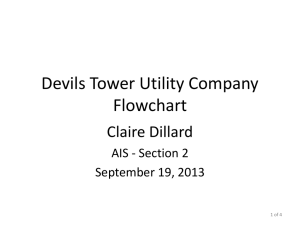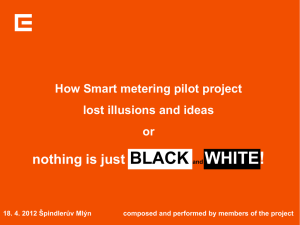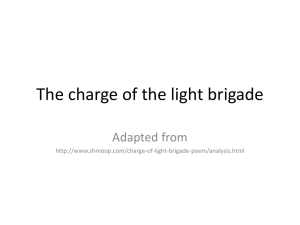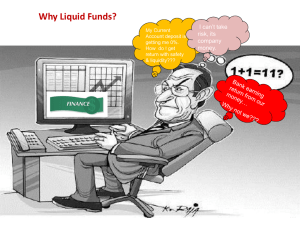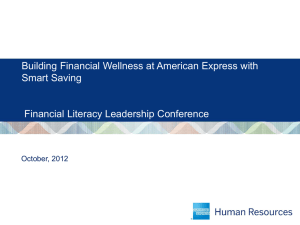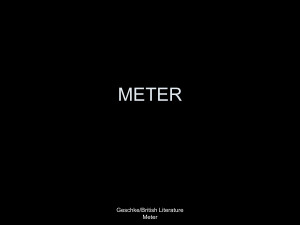Smart Meter Incremental Revenue Requirement Rate Rider
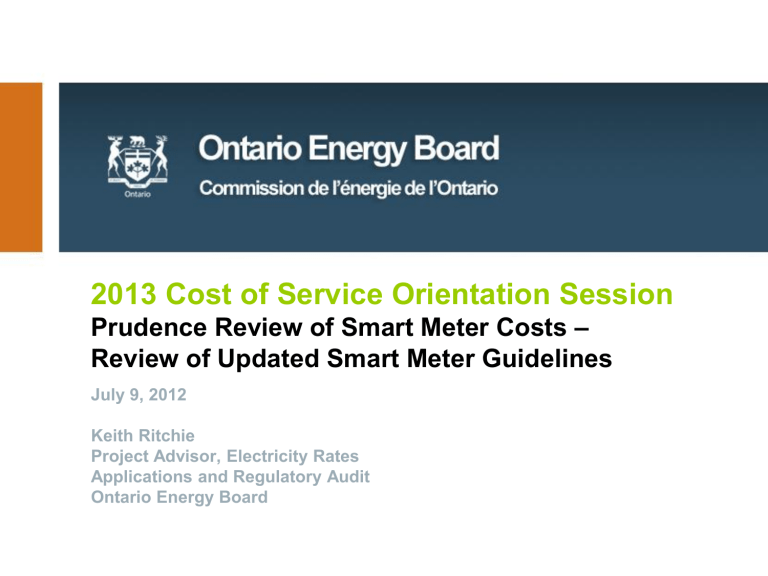
2013 Cost of Service Orientation Session
Prudence Review of Smart Meter Costs –
Review of Updated Smart Meter Guidelines
July 9, 2012
Keith Ritchie
Project Advisor, Electricity Rates
Applications and Regulatory Audit
Ontario Energy Board
Guideline G-2011-0001: Smart Meter Funding and Cost Recovery – Final
Disposition
• Issued December 15, 2011
• Evolution of Board policy and practice for review of applications for final disposition of smart meter costs
• Smart Meter costs dealt with in cost of service or stand-alone applications
• Stranded meter cost recovery only dealt with in cost of service applications
• Cost recovery aligned with APH FAQs
– Deferred revenue requirement
– Simple interest on opening monthly principal of OM&A and depreciation expense
– On revenue side, simple interest on opening monthly principal of SMFA revenues
• While SMFA was uniform across metered customers, there is an expectation that utility can address cost allocation
2
Smart Meter Funding Adder
• Smart Meter Funding Adder (SMFA) introduced May 1, 2006
– Intended to provide funding for smart meter initiative
– Initial level of about $0.30/month per metered customer for most utilities
– Level has been allowed to increase to $1.00 or some utility-specific amount
– Initially embedded in Monthly Service Charge but shown as a separate rate adder beginning with 2010 rates
– SMFA sunsetted as of April 30, 2012 for most distributors
3
Recovery Mechanisms for Two “Buckets” of Costs
• Smart Meter Disposition Rate Rider (SMDR)
– As part of a disposition/prudence review application, to dispose of the balances recorded in the variance accounts between:
• the deferred revenue requirement amount for reviewed/approved smart meters as of the date of the latest audited financial statements; and
• SMFA revenues and associated carrying charges amounts collected over the same time period.
• Smart Meter Incremental Revenue Requirement Rate Rider (SMIRR)
– When smart meter costs are approved on a final basis in a stand-alone application, the SMIRR is a proxy for the incremental on-going change in base rates that would result if the amounts of approved smart meter costs were factored into rate base and revenue requirement.
– Remains in effect until next Cost of Service rebasing
– Not needed when disposition part of a Cost of Service application, as the costs are directly incorporated into rate base, revenue requirement, cost allocation and rate design.
4
2013 Cost of Service
• To review/approve disposition of historical costs recorded in variance accounts
– Audited for historical period
– Actual/forecasted costs for bridge or test period
– Audited actual costs > 90% of total costs
• Review of prudence of costs
– Eligibility of costs for recovery (e.g., nature of costs in relation to smart meter minimum functionality requirements)
– Level of costs in total and on a per meter basis
– Cost levels are evaluated considering the utility’s circumstances and relative to that of other utilities
– Identify and document all costs “beyond minimum functionality”
• Proposal for recovery of stranded meter costs
– Net Book Value (NBV) of removed conventional meters
– Proposal for rate rider(s) and time period for recovery
•
Smart meter costs included in revenue requirement; stranded meters removed
5
Stand-alone and IRM Applications
Stand-alone Applications
• Prudence review
– Same as for Cost of Service
• Proposal for recovery of stranded meter costs
– Same as for Cost of Service
• SMIRR will proxy incremental revenue requirement for approved smart meters until next rebasing
• Smart Meters will enter rate base at next rebasing at the NBV at start of test year
IRM Applications
• 2013 Chapter 3 Filing
Requirements allow distributor to apply for review and disposition of smart meter costs (i.e. SMDR and
SMIRR) as part of an IRM application where the timing would coincide for the two applications.
• Will make for a more involved IRM application. However, should be manageable for Board, applicant and other parties based on experience of stand-alone applications if the applicant complies with Guideline G-2011-
0001
6
Smart Meter Model Versions
• Evolution of previous models
– 2012 Version 2.17 treated 2012 as test year for SMIRR and 2006-2011 as historical period for SMDR
– 2013 Version 2.21 treats 2013 as test year for SMIRR and 2006-2012 as historical period for SMDR
– 2013 Version 3.00 – Version 2.21 with two new pages to calculate classspecific SMDRs and SMIRRs per PowerStream and Guelph Hydro precedents
7
Lessons Learned – so far
• Per meter smart meter costs (combined capital and OM&A)
– Mid- to large-sized urban utilities maximum $190
– Board approved costs up to about $270 for some smaller LDCs (small, non-contiguous service areas, topographical and vegetative issues affecting accurate meter reading)
• While costs and revenues were not originally ordered to be tracked on a class-specific basis, distributors generally have the information – or can adequately proxy it. Where adequate data is available, cost allocation and class-specific SMDRs and SMIRRs are expected
• Adherence to Guideline G-2011-0001 and Board-issued model strongly helps
• Adequate documentation – look at stand-alone smart meter applications currently filed
8
Cost allocation and class-specific rate riders
• Distributors must address cost allocation for SMDR and SMIRR
– Two general approaches
• Guelph Hydro’s 2012 CoS
• VECC approach – class-specific modelling
– Cost Allocation
• Capital-related costs (PILs and depreciation) – capital cost weighting from cost allocation model
• OM&A – allocated by number of meters
• PILs – allocated by revenue requirement before PILs
• SMFA revenues (SMDR only) – direct allocation of SMFA revenues to applicable classes (Residential, GS < 50 kW, …) with residual
SMFA revenues evenly split between these classes
9
Guelph Hydro 2012 cost of service example
GUELPH HYDRO - 2012 COS - EB-2011-0123
Revenue Requirement for the Historical Years
2009
$42,551.42
2010
$535,381.23
2011
$1,634,988.25
Total 2009 to
2011
$2,212,920.90
Explanation
Allocator
ID and Factors Total Residential
General
Service Less than 50 kW
Total Return on Capital
Amortization and interest Expense
Operating Expenses (Note 1)
Grossed-up Taxes/PILs
TOTAL REVENUE REQUIREMENT
$45,429.25
$70,515.16
$0.00
$275,990.11
$355,587.68
$84,834.00
$454,228.78
$643,071.22
$527,410.00
$775,648.14
Weighted
Meter -Capital CWMC
Allocated per Class
$1,069,174.06
Weighted
Meter -Capital CWMC
Allocated per Class
Number of
Smart Meters
$612,244.00
Installed for each Class
Allocated per Class
Revenue
Requirement allocated to each Class
-$244,145.30
before PILs
Allocated per Class
100.00%
$775,648.14
100.00%
$1,069,174.06
49,033
$612,244.00
74.03%
$574,200.17
74.03%
$791,492.82
46,027
$574,709.98
25.97%
$201,447.97
25.97%
$277,681.24
3,006
$37,534.02
-$73,393.00
-$181,030.55
$10,278.25
$2,457,066.20
-$244,145.30
Total
$1,940,402.97
-$192,807.29
Residential
$1,747,595.68
$516,663.23
-$51,338.01
General
Service Less than 50 kW
$465,325.21
Revenue Generated from Smart Meter Funding Adder
$2,212,920.90
Percentage of costs allocated to Residential and GS
< 50 kW customer classes
$2,608,669.33
$2,212,920.90
SMFA Revenues directly attributable to class
100.00%
Revenues Generated from SMFA
Net Deferred Revenue Requirement
Residual SMFA revenues (from other metered classes) attributed evenly
Total
$2,608,669.33
-$395,748.43
Allocated per Class
Number of Metered Customers (2012)
Smart Meter Disposition Rate Rider
-$395,748.43
78.97%
91.42%
0.60%
92.02%
$ 2,400,436.56
-$652,840.88
47,848
-$1.14
21.03%
7.39%
0.60%
7.98%
$208,232.77
$257,092.45
3,788
$5.66
Note (1): The Operating Expenses were reduced by $89,067 to reflect the SH&ED Tax Credit -
Energy Probe TCQ # 21 c
Smart Meter Funding Adder Revenues
Year
From 'Rate Class Customer Model" of Guelph's weather normalization load forecast model spreadsheet filed in the application.
Number of customers
Residential GS < 50 kW Other Metered Residential
Estimated SMFA Revenues
GS < 50 kW Other Metered Total
2006 (May 1, 2006)
2012 (to March 30, 2012)
2007
2008
2009
2010
2011
41,643
42,728
43,747
44,584
45,477
46,647
47,848
3,468
3,534
3,581
3,624
3,661
3,724
3,788
Customer Classes
554
566
584
583
589
603
617
$
$
$
$
$
$
138,439.53
269,481.01
535,002.00
545,719.00
623,207.69
167,946.89
$ 7,491.78
$ 11,449.89
$
$
$
$
$
22,057.93
43,485.00
43,929.00
49,749.17
13,295.23
Customer Classes
$
$
$
$
$
$
$
1,196.28
1,832.76
3,597.44
6,990.00
7,070.00
8,053.93
2,165.08
$ 98,635.86
Even allocation
Allocation of 1.19% to Res and GS < 50 kW
91.42%
78.97%
50.00%
0.596%
92.02%
$ 191,458.00
7.39%
21.03%
50.00%
0.596%
7.98%
1.19%
$ 2,592,107.40
100.00%
10
Things to watch for
• 90% of smart meter costs (historical and test) should be audited actuals
• TOU implementation costs are “beyond minimum functionality” as defined in legislation and Guideline G-2011-0001
– Provide disaggregation and explanation of costs “beyond minimum functionality”
• Stranded Meters
– While stranded meters are not dealt with outside of a cost of service application, stranded meters continue to be depreciated as the assets continue to be in rate base and attract a return on capital and depreciation expense.
–
Stranded meter rate riders should generally be class-specific, relating to how these costs should have been directly allocated in cost allocation studies.
11
Things to watch for (continued)
• Explain any negative costs on sheet 2
• Check cost of capital parameters against previous cost of service applications
• Tax rates should correspond with rates used for tax/PILs expense in cost of service or with tax-sharing module of IRM applications
• Sheet 8A calculating interest on monthly OM&A and depreciation expense is preferred to annual average calculations on sheet 8B, and data should be available from Account 1556 sub-accounts
• SMDR (Residential) > SMDR (GS < 50 kW) is indication of misallocation of costs or revenues
12
13

